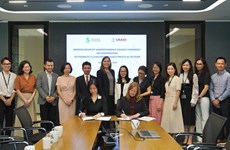ASEAN market: moving from deficit to opportunity
Two-way trade between Vietnam and
the Association of Southeast Asian Nations (ASEAN) has gone up steadily
each year but still records a deficit, said the Ministry of Industry and
Trade.
Two-way trade between Vietnam and
the Association of Southeast Asian Nations (ASEAN) has gone up steadily
each year but still records a deficit, said the Ministry of Industry and
Trade.
Head of the ministry’s Asia-Pacific Department Dao Tran Nhan said that two-way trade registered an annual average growth rate of nearly 26 percent during the 2005-08 period, reaching 29.8 billion USD in 2008, doubling 2005’s figure. The figure was only just over 22.4 billion USD in 2009 due to the impact of the global economic crisis, and a year-on-year decrease of almost 25 percent.
In the first quarter of 2010, however, two-way trade exceeded 6.1 billion USD, a year-on-year rise of 37 percent, making up nearly 19 percent of the country’s import-export revenue.
As a result, ASEAN has become the third largest importer of Vietnamese goods, following the US and the European Union (EU). The bloc is also Vietnam ’s second biggest goods supplier after China .
Vietnam exports mainly textiles and apparel, footwear, crude oil, rice, electronic components, seafood, coffee and fruits and vegetables to ASEAN with export revenues of crude oil and rice making up more than 42 percent of Vietnam ’s total to the bloc.
Within the bloc, Singapore , Thailand and Malaysia are leading importers of Vietnamese goods. Statistics have shown that the value of goods exchanged with the three partners accounted for 72 percent of Vietnam ’s import/export revenues with ASEAN in 2009. Cambodia , Laos and the Philippines are markets with great prospects for increasing export revenues.
However, Vietnam ’s trade deficit with ASEAN rose from 4 billion USD in 2005 to 5.22 billion USD in 2009 and exceeded 1 billion USD in the first quarter of 2010.
Deputy Minister of Industry and Trade Do Huu Hao said that Vietnam ’s staples, including textiles and apparel, seafood and footwear are unable to compete against those of other ASEAN members because they are too similar.
At present, Vietnam ’s export revenues are unstable as the nation relies on crude oil and rice, which are vulnerable to price fluctuations on the world market.
Meanwhile, Vietnam imports a large volume of goods, mainly materials for domestic production, from other ASEAN members, the import value of which accounts for around 70 percent of Vietnam ’s total imports from ASEAN.
To balance trade between the two sides, Head of the ministry’s Multilateral Trade Policy Department Tran Quoc Khanh advised businesses to adopt new strategies and products while relying on the bloc to penetrate other economic regions.
Economic experts said that opportunities for Vietnamese goods to penetrate the ASEAN market of more than 500 million people remain numerous due to the establishment of an ASEAN-China free trade area which became effective as of the beginning of 2010 and the total removal of non-tariff barriers inside ASEAN in 2015./.
Head of the ministry’s Asia-Pacific Department Dao Tran Nhan said that two-way trade registered an annual average growth rate of nearly 26 percent during the 2005-08 period, reaching 29.8 billion USD in 2008, doubling 2005’s figure. The figure was only just over 22.4 billion USD in 2009 due to the impact of the global economic crisis, and a year-on-year decrease of almost 25 percent.
In the first quarter of 2010, however, two-way trade exceeded 6.1 billion USD, a year-on-year rise of 37 percent, making up nearly 19 percent of the country’s import-export revenue.
As a result, ASEAN has become the third largest importer of Vietnamese goods, following the US and the European Union (EU). The bloc is also Vietnam ’s second biggest goods supplier after China .
Vietnam exports mainly textiles and apparel, footwear, crude oil, rice, electronic components, seafood, coffee and fruits and vegetables to ASEAN with export revenues of crude oil and rice making up more than 42 percent of Vietnam ’s total to the bloc.
Within the bloc, Singapore , Thailand and Malaysia are leading importers of Vietnamese goods. Statistics have shown that the value of goods exchanged with the three partners accounted for 72 percent of Vietnam ’s import/export revenues with ASEAN in 2009. Cambodia , Laos and the Philippines are markets with great prospects for increasing export revenues.
However, Vietnam ’s trade deficit with ASEAN rose from 4 billion USD in 2005 to 5.22 billion USD in 2009 and exceeded 1 billion USD in the first quarter of 2010.
Deputy Minister of Industry and Trade Do Huu Hao said that Vietnam ’s staples, including textiles and apparel, seafood and footwear are unable to compete against those of other ASEAN members because they are too similar.
At present, Vietnam ’s export revenues are unstable as the nation relies on crude oil and rice, which are vulnerable to price fluctuations on the world market.
Meanwhile, Vietnam imports a large volume of goods, mainly materials for domestic production, from other ASEAN members, the import value of which accounts for around 70 percent of Vietnam ’s total imports from ASEAN.
To balance trade between the two sides, Head of the ministry’s Multilateral Trade Policy Department Tran Quoc Khanh advised businesses to adopt new strategies and products while relying on the bloc to penetrate other economic regions.
Economic experts said that opportunities for Vietnamese goods to penetrate the ASEAN market of more than 500 million people remain numerous due to the establishment of an ASEAN-China free trade area which became effective as of the beginning of 2010 and the total removal of non-tariff barriers inside ASEAN in 2015./.













